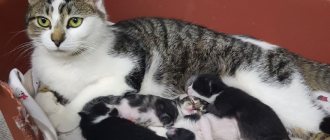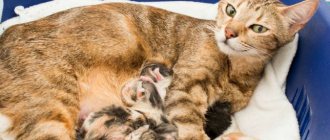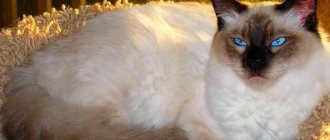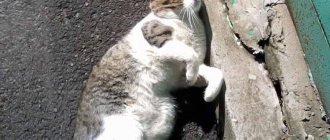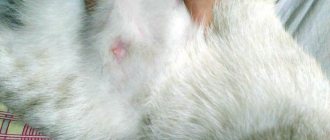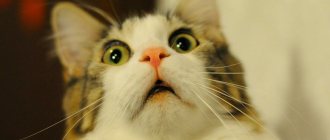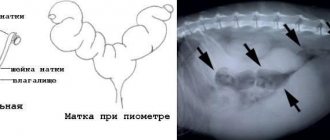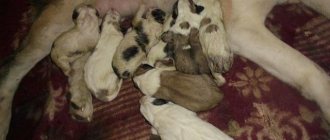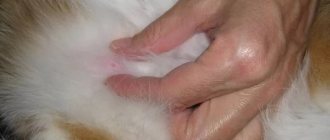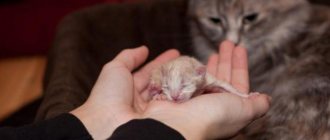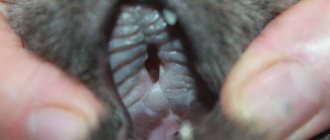Features of the birth process in cats
Quite often there are cases when, after the birth of one or several kittens, the cat stops pushing. In veterinary medicine, this condition is usually called interrupted labor. At the same time, the female behaves completely calmly, feeds and licks the newborn cubs, drinks water and can even eat food. The fact that labor has not yet ended is evidenced only by the remaining enlarged abdomen, in which the movement of unborn kittens is observed.
The duration of such pauses can be up to 36 hours, after which viable, healthy kittens are born. During the rest period, the female rests, regains strength and usually easily gives birth to the remaining cubs without human help.
Important! If the break lasts longer or fetal freezing occurs (visual lack of movement in the abdominal cavity), then you should immediately contact a veterinarian.
While present at birth, the owner should not interfere with the process if the female independently ruptures the amniotic membranes of the fetus, separates the umbilical cord and performs other manipulations. But if she stops coping with her duties, becomes lethargic and apathetic, and the force of pushing noticeably weakens, then it is urgent to call a veterinary specialist.
How to prepare for the birth of a cat?
A cat does not need a birthing room like a human, but a special place will have to be arranged.
A special box, which you can make yourself or buy at a pet store, is suitable as a “maternity box”. A cardboard box lined with newspapers or an old blanket will do just fine. If the cat has access to the street, then in the last stages it is better not to let her out in order to prevent birth on the street. Also in the last days it is worth ensuring peace, absence of noise and other irritants and monitoring whether the animal’s condition changes.
In case complications arise during childbirth, it is better to prepare some supplies in advance; here is the necessary list:
- Any antiseptic
- Towels
- Treated scissors
- Pipette
- Sterile medical gloves
- Veterinarian phone number
Unfinished labor
If a cat has a large belly after giving birth, this may mean that there are still kittens in the uterus. This can be determined by carefully palpating the female’s abdominal cavity from both sides, starting from the hypochondrium area. But an inexperienced owner can easily confuse internal organs with frozen fruits and make hasty, incorrect conclusions. Therefore, you should not immediately panic and take measures to stimulate labor on your own.
Very important! Under no circumstances should you inject a drug that stimulates uterine contractions (oxytocin) without the consent of your veterinarian. If the fetus is stuck in the birth canal as a result of its malpresentation, then strong contractions of smooth muscles can lead to rupture of the uterine horns and internal bleeding.
The following signs indicate unfinished labor:
- the female maintains the body position characteristic of the birth period;
- she is not active in caring for newborn kittens;
- the cat may notice periodically repeated weak attempts;
- the animal refuses water;
- the stomach remains hard and tense.
Induction of labor
If the due date has come, the cat’s body temperature has dropped to 37°C, more than two days have passed, then you need to know how to induce labor in a cat. First, they try simple remedies: massage the tummy and nipples: this will cause the production of oxytocin, and it will start the process of contractions. It is dangerous to administer oxytocin on your own - physiological unpreparedness for lambing can lead to cervical rupture.
We recommend reading: How to Treat a Cat for Distemper at Home
If two days have already passed, signs of labor are evident, but the process has not started, then contact a veterinarian.
a house that the cat will examine and “accept” in advance;
Yesterday my Sphynx cat, who has been living with me for a month, and which I bought already coated, gave birth and gave birth to 5 kittens. The birth was good, the kitty did everything herself and very well, the kittens were suckling, the cat ate poop and was feeding the babies. In general, everything is fine, except that her stomach still looks like there are kittens in it, and is hard. She ate all the afterbirth. Today we received an injection of oxytocin, 0.4 ml. No reaction. We doubted and argued for a long time, and decided to show the kitty to the doctor. According to the previous breeder, she gave birth to a kitty 3 times and always without problems. The funniest thing is that the kitty's passport only has a year and two months on it. When did she have time? In short, it’s already clear that I was duped somewhere. What the doctor did: they took an x-ray, and immediately said that it was necessary to operate. Allegedly, there is an accumulation of water and gases inside, most likely in the uterus. All this puts pressure on the spine from below. The bladder was not visible, the intestines were also not visible in the picture (by the way, the kitty peed on the way). The first picture was taken from the side, the second from above, with the kitty lying on its back. They ruled out kittens with almost certainty, since there were no skeletons visible. The temperature is 39.2, in short, the most normal. Of course, we refused the operation. What that means is that we don’t know what exactly is going on here, but we are ready to cut now. I'm shocked. everything is still there. What to do. Maybe this is normal and the fluid will disappear. The cat, upon returning home, immediately began to feed the kittens and ate. The doctor prescribed Sinulox antibiotics. But I’m not entirely sure whether it’s necessary. But the big and hard belly is sooooo embarrassing.
Even experienced cat lovers sometimes get a lot of anxiety when their pet is about to give birth. Of course, the likelihood of developing birth complications in these animals is very low, but still they should not be completely ruled out. In particular, when a cat gives birth, you need to know for sure whether all the kittens have been born... But how to do this?
Complications during lambing occur quite rarely, but purebred cats are more pampered than their yard sisters, so monitoring and assistance are required during pregnancy and childbirth. If you take a closer look at the behavior of the animal, the following phenomena can cause anxiety:
- Mismatch in the number of placenta and kittens born.
- Emerging attempts.
- The cat does not get up or change position for a very long time.
- Lethargic, apathetic, does not drink or eat anything.
- Increased body temperature.
- The woman in labor cannot sleep.
- Tight, bloated belly.
- After 24 hours the bleeding did not stop.
- The discharge has an unpleasant odor and is green in color.
All this indicates that the cat has an unfinished lambing, or the placenta has not been delivered and she needs emergency help.
Retention of placenta
A large, dense belly after giving birth in a cat may be a consequence of retention of the placenta. Normally, within a few minutes after the kitten is born, the placenta comes out. Therefore, while observing the birth process, the owner must ensure that their numbers match.
Sometimes this is difficult to do due to the fact that the cat quickly eats the placenta. Then you should carefully monitor the animal for three days after birth and contact a veterinarian if you notice the following symptoms:
- tense abdominal walls;
- lack of appetite;
- weak interest in kittens;
- presence of dark brown vaginal discharge with an unpleasant odor;
- an increase in general body temperature above 39 degrees Celsius.
If measures to remove the placenta are not taken in time, inflammation of the internal genital organs will begin, leading to sepsis and death.
Signs of completion of labor
A slightly enlarged belly in a cat after childbirth may be a consequence of:
- physiological characteristics of the animal’s body;
- multiple pregnancy;
- the presence of large cubs;
- obesity;
- weak muscle tone of the abdominal wall.
In this case, the walls of the abdominal cavity are soft, without compaction. The female behaves calmly, changing her body position, leaving the nest for a short time, licking and feeding the offspring. A characteristic sign of the end of labor is severe thirst . But there may be no appetite on the first day due to saturation with afterbirth.
It is very important to carefully monitor the behavior of the female during the postpartum period , as some diseases may appear after a few days. If you notice any deviations from the norm, you must contact a veterinary medicine clinic and get qualified help from a specialist.
Normal or pathological?
A pet's stomach that is too hard is not normal. Only cases when the animal is frightened can be considered the norm. At the same time, the cat deliberately tenses his abdominal muscles to protect the vulnerable area.
This behavior is typical for animals that have previously been abused by people. This is usually encountered by owners of kittens recently taken from the street. No specific treatment is required, since a hard abdomen in this case acts as a protective reaction and not a symptom of the disease. The problem will be solved over time, when the animal gets used to the house and ceases to be afraid of people.
In all other cases, hard abdominal muscles are a reason to consult a veterinarian. In this case, the behavior of the pet is of great importance. If swelling and hardness of the muscles are accompanied by a loss of strength and difficulty defecating, the cat must be urgently hospitalized.
Dangerous symptoms
As you can see, if a cat has sagging skin on its belly, there is no reason to worry. This is an absolutely normal process that does not harm the health of the animal. If the owner is bothered by such a fat tail, it is enough to change the diet and stop overfeeding the pet.
If the cat reacts inappropriately to touching its sagging belly, looks unhealthy and loses appetite, you should consult a doctor. One possible reason for this behavior could be parasite infection. Young animals who spent their childhood on the streets most often encounter a large number of worms in the abdominal cavity. Associated symptoms in this case:
- swelling and tenderness of the abdomen;
- hair loss;
- diarrhea;
- weak appetite;
- lethargy and drowsiness.
In this case, worms will definitely be found in the animal’s feces. In especially severe cases, profuse vomiting is possible. This condition cannot be treated at home. Mass death of worms will lead to severe intoxication of the body, and a weakened animal may not tolerate this. Removal of parasites should only be carried out under the supervision of a physician. At the same time, in addition to anthelmintic drugs, the cat is given droppers that cleanse the body and given injections of special drugs.
Intrauterine infections are indicated not by a sagging, but, on the contrary, by a dense and swollen abdomen, so this variant of the disease should be immediately excluded. In order not to worry in vain, the owner should simply monitor the behavior of the pet. If the animal is active, has a good appetite, and does not avoid touching and stroking, there is no cause for concern.
Hard belly and constipation
Quite often, changes in the tone of the abdominal muscles are associated with constipation. If a cat has a swollen, hard belly and has not had a bowel movement for a long time, the cause of this phenomenon should be sought in the pet’s diet.
Constipation may be associated with helminthic infestation or intestinal obstruction. In the first case, additional symptoms are present:
- frequent vomiting;
- deterioration in wool quality;
- prostration;
- refusal of food.
Constipation is associated with a large number of parasites in the digestive tract and intestines. Constipation causes severe distension of the intestines, which provokes a reflex contraction of the abdominal muscles.
Intestinal obstruction is a dangerous condition that can lead to intoxication of the animal’s body. Pathology develops due to poor nutrition or consumption of inedible items. Characteristic symptoms of intestinal obstruction are a long absence of bowel movements, refusal to eat and constant vomiting. This condition requires hospitalization.
Signs of completion of labor in a cat
Lambing went well and all kittens were born if the cat has:
- Smooth breathing, normal temperature.
- The cat licked and fed the offspring.
- She got up to drink and eat.
- Shows no signs of restlessness and is sleeping.
- The abdomen is soft on palpation.
We recommend reading: Treating a Cat for Worms
Occasionally, labor is interrupted without signs of discomfort. This is a natural defense that works if the cat was exhausted or was catting heavily. As soon as the body regains strength, lambing continues after a certain time.
Changes in muscle tone during pregnancy
In most cases, pregnancy in cats is easy. The cat does not feel any discomfort, but is reluctant to be handled and strains its abdominal muscles when trying to feel it. A very hard belly in a cat may indicate a pathologically developing pregnancy. This condition ends in miscarriage and is accompanied by changes in the pet’s behavior - she refuses to eat, drinks a lot, behaves restlessly and constantly meows. In the early stages, detecting a miscarriage in a cat is problematic, while pregnancy failure in the later stages is accompanied by heavy bleeding.
